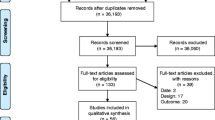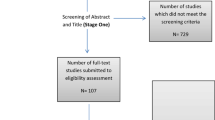Abstract
Introduction Work disability after injury is a complex problem, and there remains a lack of clarity about what factors are most influential on whether or not someone will experience difficulty returning to work. Increasingly, expectations and injury perceptions are being explored as potential factors in work disability, because of their role in influencing behaviours. Methods This paper reviewed the literature regarding how expectations (regarding injury recovery and return to work) and injury perceptions relate to return to work outcome. A wide range of electronic journal databases were searched, and identified articles were critically appraised to assess quality and relevance. Results were then synthesised and discussed in relation to the evidence available regarding the role of expectations and injury perceptions in return to work, and implications for practice and further research. Results Findings showed that evidence regarding to how both expectations and injury perceptions contribute to return to work outcome is limited. Some suggestions for application to practice are made. Methodological issues and key points to consider for future research are discussed. Conclusions While in general little is known about how much expectations and injury perceptions influence return to work outcome, it is clear that the issue requires further investigation. Key limits to current knowledge result from inadequate methods of measuring expectation/s, lack of clear definitions of ‘return to work outcome’ and differences in timeframes and populations. Never-the-less, there is promising evidence to suggest that, in particular, pain catastrophizing research is warranted due to its correlation with outcome and amenability to change.
Similar content being viewed by others
References
Stover B, Wickizer TM, Zimmerman F, Fulton-Kehoe D, Franklin G. Prognostic factors of long-term disability in a workers’ compensation system. J Occup Environ Med. 2007;49(1):31–40. doi:10.1097/01.jom.0000250491.37986.b6.
Frank J, Sinclair S, Hogg-Johnson S, Shannon H, Bombardier C, Beaton D, et al. Preventing disability from work-related low-back pain—New evidence gives new hope—if we can just get all the players onside. Can Med Assoc J. 1998;158(12):1625–31.
Turner JA, Franklin G, Fulton-Kehoe D, Sheppard L, Wickizer TM, Wu R, et al. Worker recovery expectations and fear-avoidance predict work disability in a population-based workers’ compensation back pain sample. Spine. 2006;31(6):682–9. doi:10.1097/01.brs.0000202762.88787.af.
Bowling A. Research methods in health: investigating health and health services. Philadelphia: Open University Press; 1997.
Oakley A. Design and analysis of social intervention studies in health research. In: Bowling A, Ebrahim S, editors. Handbook of health research methods: investigation, measurement and analysis. Maidenhead: Open University Press; 2005. p. 246–65.
Peat JK, Mellis C, Williams K, Zuan W. Health science research: a handbook of quantitative methods. London: SAGE Publications Ltd.; 2002.
Heijbel B, Josephson M, Jensen I, Stark S, Vingard E. Return to work expectation predicts work in chronic musculoskeletal and behavioral health disorders: prospective study with clinical implications. J Occup Rehabil. 2006;16(2):173–84. doi:10.1007/s10926-006-9016-5.
Young AE, Wasiak R, Roessler RT, McPherson KM, Anema JR, van Poppel MNM. Return-to-work outcomes following work disability: stakeholder motivations, interests and concerns. J Occup Rehabil. 2005;15(4):543–56. doi:10.1007/s10926-005-8033-0.
Sullivan MJ, Stanish W, Waite H, Sullivan M, Tripp DA. Catastrophizing, pain, and disability in patients with soft-tissue injuries. Pain. 1998;77(3):253–60. doi:10.1016/S0304-3959(98)00097-9.
Ross CE, Mirowsky J. Does employment affect health? J Health Soc Behav. 1995;36(3):230–43. doi:10.2307/2137340.
Pransky G, Gatchel R, Linton SJ, Loisel P. Improving return to work research. J Occup Rehabil. 2005;15(4):453–7. doi:10.1007/s10926-005-8027-y.
Petticrew M, Roberts H. Systematic reviews in the social sciences: a practical guide. Malden, Oxford, Victoria: Blackwell; 2006.
Khan KS, ter Riet G, Glanville J, Sowden AJ, Kleijnen J, editors. Undertaking systematic reviews of research on effectiveness: CRD’s guidance for those carrying out or commissioning reviews. NHS Centre for Reviews and Dissemination, University of York: York; 2001.
Schultz IZ, Stowell AW, Feuerstein M, Gatchel RJ. Models of return to work for musculoskeletal disorders. J Occup Rehabil. 2007;17(2):327–52. doi:10.1007/s10926-007-9071-6.
Sullivan MJ, Charles Ward L, Tripp D, French DJ, Adams H, Stanish WD. Secondary prevention of work disability: community-based psychosocial intervention for musculoskeletal disorders. J Occup Rehabil. 2005;15(3):377–92. doi:10.1007/s10926-005-5944-7.
Fineout-Overholt E, Melnyk B. Building a culture of best practice. Nurse Leader. 2005;3(6):26–30.
Public Health Resource Unit. Critical appraisal skills programme: making sense of evidence. 2002 (cited 28 February, 2007); Available from: http://www.phru.nhs.uk/casp/casp.htm.
Magnussen L, Strand LI, Skouen JS, Eriksen HR. Motivating disability pensioners with back pain to return to work—a randomized controlled trial. J Rehabil Med. 2007;39(1):81–7. doi:10.2340/16501977-0004.
Chan SK, Man DW. Barriers to returning to work for people with spinal cord injuries: a focus group study. Work (Reading, Mass.). 2005;25(4):325–32.
Chapin MH, Kewman DG. Factors affecting employment following spinal cord injury: a qualitative study. Rehabil Psychol. 2001;46(4):400–416. doi:10.1037/0090-5550.46.4.400.
Shaw WS, Huang YH. Concerns and expectations about returning to work with low back pain: identifying themes from focus groups and semi-structured interviews. Disabil Rehabil. 2005;27(21):1269–81. doi:10.1080/09638280500076269.
Sullivan MJ, Stanish WD. Psychologically based occupational rehabilitation: the Pain-Disability Prevention Program. Clin J Pain. 2003;19(2):97–104. doi:10.1097/00002508-200303000-00004.
Sullivan MJL, Adams H, Rhodenizer T, Stanish WD. A psychosocial risk factor-targeted intervention for the prevention of chronic pain and disability following whiplash injury. Phys Ther. 2006;86(1):8–18.
Fritz JM, George SZ, Delitto A. The role of fear-avoidance beliefs in acute low back pain: relationships with current and future disability and work status. Pain. 2001;94(1):7–15. doi:10.1016/S0304-3959(01)00333-5.
Fritz J, George SZ. Identifying psychosocial variables in patients with acute work-related low back pain: the importance of fear-avoidance beliefs. Phys Ther. 2002;82(10):973–83.
Boersma K, Linton SJ. Screening to identify patients at risk: profiles of psychological risk factors for early intervention. Clin J Pain. 2005;21(1):38–43. doi:10.1097/00002508-200501000-00005.
Tate RB, Yassi A, Cooper J. Predictors of time loss after back injury in nurses. Spine. 1999;24(18):1930–5. doi:10.1097/00007632-199909150-00012.
Cole DC, Mondloch MV, Hogg-Johnson S. Listening to injured workers: how recovery expectations predict outcomes—a prospective study. Can Med Assoc J. 2002;166(6):749–54.
Hogg-Johnson S, Cole DC. Early prognostic factors for duration on temporary total benefits in the first year among workers with compensated occupational soft tissue injuries. Occup Environ Med. 2003;60(4):244–53. doi:10.1136/oem.60.4.244.
Schonherr MC, Groothoff JW, Mulder GA, Schoppen T, Eisma WH. Vocational reintegration following spinal cord injury: expectations, participation and interventions. Spinal Cord. 2004;42(3):177–84. doi:10.1038/sj.sc.3101581.
Kapoor S, Shaw WS, Pransky G, Patterson W. Initial patient and clinician expectations of return to work after acute onset of work-related low back pain. J Occup Environ Med. 2006;48(11):1173–80. doi:10.1097/01.jom.0000243401.22301.5e.
Shaw WS, Pransky G, Patterson W, Linton SJ, Winters T. Patient clusters in acute, work-related back pain based on patterns of disability risk factors. J Occup Environ Med. 2007;49(2):185–93. doi:10.1097/01.jom.0000254205.47334.c3.
Shaw WS, Pransky G, Patterson W, Winters T. Early disability risk factors for low back pain assessed at outpatient occupational health clinics. Spine. 2005;30(5):572–80. doi:10.1097/01.brs.0000154628.37515.ef.
Gibson L, Strong J. Assessment of psychosocial factors in functional capacity evaluation of clients with chronic back pain. Brit J Occup Ther. 1998;61(9):399–404.
Woby S, Watson P, Roach N, Urmstom M. Adjustment to chronic low back pain—the relative influence of fear-avoidance beliefs, catastrophizing, and appraisals of control. Behav Res Ther. 2004;42(7):761–74. doi:10.1016/S0005-7967(03)00195-5.
Sullivan M, Bishop S, Pivik J. The pain catastrophizing scale: development and validation. Psychol Assessment. 1995;7:524–32. doi:10.1037/1040-3590.7.4.524.
Kori S, Miller R, Todd D. Kinesophobia: a new view of chronic pain behaviour. Pain Manage. 1990;3:35–43.
Elfving B, Andersson T, Grooten W. Low levels of physical activity in back pain patients are associated with high levels of fear-avoidance beliefs and pain catastrophizing. Physiother Res Int. 2007;12(1):14–24. doi:10.1002/pri.355.
Vlaeyen J, Kole-Snijders A, Boeren R, van Eek H. Fear of movement/(re)injury in chronic low back pain and its relation to behavioral performance. Pain. 1995;62:363–72. doi:10.1016/0304-3959(94)00279-N.
Sandstrom J, Esbjornsson E. Return to work after rehabilitation—the significance of the patients own prediction. Scand J Rehabil Med. 1986;18(1):29–33.
Schultz I, Crook J, Berkowitz J, Milner R, Meloche G. Predicting return to work after low back injury using the psychosocial risk for occupational disability instrument: a validation study. J Occup Rehabil. 2005;15(3):365–76. doi:10.1007/s10926-005-5943-9.
Schultz IZ, Crook JM, Berkowitz J, Meloche GR, Milner R, Zuberbier OA, et al. Biopsychosocial multivariate predictive model of occupational low back disability. Spine. 2002;27(23):2720–5. doi:10.1097/00007632-200212010-00012.
Krause N, Frank JW, Dasinger LK, Sullivan TJ, Sinclair SJ. Determinants of duration of disability and return-to-work after work related injury and illness: challenges for future research. Am J Ind Med. 2001;40:464–84. doi:10.1002/ajim.1116.
Amik BC, Lerner D, Rogers WH, Rooney T, Katz JN. A review of health-related work outcome measures and their uses, and recommended measures. Spine. 2000;25(24):3152–60. doi:10.1097/00007632-200012150-00010.
Patel S, Greasley K, Watson PJ. Barriers to rehabilitation and return to work for unemployed chronic pain patients: a qualitative study. Eur J Pain (London, England). 2007;11(8):831–840. doi:10.1016/j.ejpain.2006.12.011.
Shaw L, Segal R, Polatajko H, Harburn K. Understanding return to work behaviours: promoting the importance of individual perceptions in the study of return to work. Disabil Rehabil. 2002;24(4):185–95. doi:10.1080/09638280110066299.
Eklund M. Chronic pain and vocational rehabilitation: a multifactorial analysis of symptoms, signs and psycho-socio-demographics. J Occup Rehabil. 1992;2(2):53–66. doi:10.1007/BF01079012.
Foreman P, Murphy G. Work values and expectancies in occupational rehabilitation: the role of cognitive variables in the return-to-work process. J Rehabil. 1996;62(3):44–8.
Gross DP, Battie MC. Work-related recovery expectations and the prognosis of chronic low back pain within a workers’ compensation setting. J Occup Environ Med. 2005;47(4):428–33. doi:10.1097/01.jom.0000158706.96994.a5.
Schultz I, Crook J, Meloche G, Berkowitz J, Milner R, Zuberbier O, et al. Psychosocial factors predictive of occupational low back disability: towards development of a return-to-work model. Pain. 2004;107(1–2):77–85. doi:10.1016/j.pain.2003.09.019.
Magnussen L, Strand L, Skouen JS, Eriksen HR. Motivating disability pensioners with back pain to return to work—a randomised control trial. J Rehabil Med. 2007;39:81–7. doi:10.2340/16501977-0004.
Fritz JM, George SZ. Identifying psychosocial variables in patients with acute work-related low back pain: the importance of fear-avoidance beliefs. Phys Ther. 2002;82(10):973–83.
Lange C, Burgmer M, Braunheim M, Heuft G. Prospective analysis of factors associated with work reentry in patients with accident-related injuries. J Occup Rehabil. 2007;17(1):1–10. doi:10.1007/s10926-006-9039-y.
Dozois DJ, Dobson KS, Wong M, Hughes D, et al. Factors associated with rehabilitation outcome in patients with low back pain (LBP): prediction of employment outcome at 9-month follow-up. Rehabil Psychol. 1995;40(4):243–59. doi:10.1037/0090-5550.40.4.243.
Gatchel RJ, Polatin PB, Kinney RK. Predicting outcome of chronic back pain using clinical predictors of psychopathology—a prospective analysis. Health Psychol. 1995;14(5):415–20. doi:10.1037/0278-6133.14.5.415.
Shaw WS, Huang Y-H. Concerns and expectations about returning to work with low back pain: identifying themes from focus groups and semi-structured interviews. Disabil Rehabil. 2005;27(21):1269–81. doi:10.1080/09638280500076269.
Acknowledgement
Appreciation is extended to Amanda E. Young for her comments on an early draft of this paper.
Author information
Authors and Affiliations
Corresponding author
Appendix
Appendix
Rights and permissions
About this article
Cite this article
Fadyl, J., McPherson, K. Return to Work After Injury: A Review of Evidence Regarding Expectations and Injury Perceptions, and their Influence on Outcome. J Occup Rehabil 18, 362–374 (2008). https://doi.org/10.1007/s10926-008-9153-0
Received:
Accepted:
Published:
Issue Date:
DOI: https://doi.org/10.1007/s10926-008-9153-0




